Marc MacYoung?
Dianna Gordon MacYoung?
Animal E-list
Crime Avoidance Lectures
Crime Blog
Colorado Classes
Contact Us
FAQs
Hosting A Seminar
Crime Prevention
Expert Witness
Knife Defense
Law Enforcement
Martial Arts
Military
Movie Consulting
Women's Self-Defense
Links
Our Linking Policy
On-line Store
Train with MacYoung
Testimonials
Terms of Use
Topics
of Interest
It would therefore, be a great
mistake to draw the conclusion
that a blind dash must always gain the victory over
skill and caution,
an unskillful attack would lead to the destruction
of our own and
not of the enemy's force, and therefore is not what
is here meant. The superior efficacy belongs not to the
means, but to the end.
Carl von Clausewitz
On War
Mushy Body Movement
On this page:
Physics in Training |
Kinesthetic Awareness/Physical IQ |
Single/ Combined/ Sequential body movement |
Thinking You Know How to Generate Power: Speed/Momentum/Muscle |
In Conclusion |
Further Resources
Whether you study a traditional martial art, a modern martial art, a self-defense system, defensive tactics or close quarter combat, all must meet one basic criteria: They must teach you how to control force.
Notice I didn't say 'generate.' That's because generating force is only one aspect of controlling force. Specifically, you must be able to both deliver force into your opponent and handle the force he is attempting to deliver into you. It doesn't matter what you are learning, all must meet this dual issue regarding force.
With this in mind one can, look beyond the hype, spin and salesmanship and assess the effectiveness of what you are being taught. The physics and mechanics of any effective system can be analyzed, demonstrated and most of all, explained. Whereas ineffective systems quickly are revealed under this pragmatic approach.
Categorically, it is the effective body movement of any system that is what makes it work.
Let me put that in simple terms: It's NOT the style that has power. It's how well they can teach you to move in a way to generate power. If you're not moving in a way to generate power, then all you are doing is sticking your fist out in the air. And if you aren't being taught how to deliver that power, then you're pissing it away.
Without these fundamental elements, there is no creation or delivery of power. Odds are you will have only limited success for controlling the power that he might deliver into you.
This is why you should always pay close attention to issues like footwork, body movement and body pose. These issues are the meat and potatos of a system they are what makes it work. Unfortunately, an emphasis on hand work, kicks and combinations often eclipse these aspects because the former look far more impressive and flashy. The emphasis that is paid to these power generating elements is one of the standards by which you can judge the effectiveness of either a system or a teacher. The less emphasis, the less effective.
Physics in Training
FirstConcept: Different martial arts styles use
different body movement systems to generate force.
Simply stated, certain "tools" (hand positions, strikes, kicks, etc) work best with specific kinds of body movement. Bruce Lee was wrong "a punch is not just a punch." Particular punches are designed to work with specific body movements. A kung fu "hanging punch" does not operate with the same body mechanics as a boxing hook. Usually, a martial art style will have tools that are most effective with the specific body movement that the style employs. Having said this three related points arise
When these students become instructors, the elements of correct body movement in relationship to tools is lost. These people cannot teach what they never knew. Nor can they correctly identify which movements their students are doing that are power generating as opposed to power robbing. Therefore, this lack of understanding regarding power generation is passed on from instructor to instructor. This brings us to the next point.
B) Quite often, having seen this degeneration of power in the system, the head instructor brings in body movement from other systems in order to "patch" the system (e.g. introducing boxing elements into a karate system). Instead of strengthening the system, it often results in further weakening of it. This from not understanding the tool/body movement relation, and again, trying to hang all the tools off either the same movement or variations thereof.
C) One of the biggest failings of cross training is when someone from one style attempts to apply his original body mechanics to the moves of a different system. This is why you will so often see what we call "wing chun flavored karate" or "silat flavored FMA" instead of "pure" Wing Chun or Silat. The bodymechanics of these different arts are radically different. But what you will often see with people who claim to be able to teach you multiple styles is the body movement of their original art mixed with the handwork/tools of secondary arts.
When any of these points occur, you get "mush." That is to say the resulting physics -- unlike a stronger blended alloy -- are neither one or the other. You end up with movement that has neither the power nor the structure of either pure form.
Having said all this, while it is possible to effectively cross train, and it is also possible to bring in body movement from other styles, great care and attention must be paid to maintaining clean body movement for the tool being applied. Failure to do so will result in mush.
Second Concept: Different bodies move differently. There are certain moves that some people just can't do. Their body just doesn't work that way. Your body might not work with how a martial art system creates force.
This is why it is advisable for a beginning/intermediate student to find a system that works well with how your body works. You will learn such an art easier and faster than one that forces you to move in a manner different than how your body normally works. If however, you are in a profession that you need to apply physical force, finding a system/training that immediately works with your body mechanics is critical. Don't waste time learning things that -- while they may work for others -- don't work for you. For advanced students in the MA, it is advisable to seek training, not in similar systems that you are proficient at, but in systems that have radically different body movement than what you are proficient at. You're not growing as a martial artist if despite having several rankings, they are basically all the same body movement system.
Third Concept, is there is no ONE ULTIMATE WAY of generating force. Any system that contains an understanding of body movement, structure and range can knock you into next week. What's more is that each of these different types of pure body movement creates different sets of physics, angles and force. Three interesting points arise from this single fact.
B) When it comes to blocking, these small, subtle, but important differences in how each way creates force are often enough to create an over-specialization within a style. Specializations that work to stop the attacks practiced within that style, but leave the student vulnerable to attacks from different styles.
C) Much of the argument over which type of movement is Right vs. Wrong is, in fact, over the mush that results when they are badly blended.
The preceding section was just to acquaint you with the playing field. To get you up to speed on some of the issues that can and will affect your ability to generate/receive force (2) Now let's look at what you must be aware of to create effective body movement.
Kinesthetic Awareness/Physical
IQ
Those who are fixated on the combat/self-defense
application of their training or who are deeply
involved with hardcore sport systems will probably
not have the experience of teaching martial arts to
children. Which is a pity because it is through
teaching children that we realized the fundamental
flaw that people are doing to rob themselves of
power when they move.
If, as a MA instructor you tell a child to do one move only, the child will usually do about sixteen. If you tell a child to move into a particular pose, instead of simply moving into the stance, that child's body will go all over the board. The pose that the child ends up will only vaguely resemble what you are trying to teach him/her. And then the child will look at you in complete earnestness and say "I did what you told me to do" The child truly believes that he/she only did one move and is in the position he/she is supposed to be in.
The reason this happens is a child's kinesthetic awareness is slim to none and Slim left town. In short, children really don't know where their body is in time and space. The parts are going all over everywhere. This is also why so often when you tell a child to be careful and they still drop something they protest that they were being careful. As far as their kinesthetic developmental level allows, they were. This also explains why during growth spurts children and teens become more klutzy. Their bodies have changed size and their kinesthetic awareness has not adapted to the changes yet.
The theory that there is such a thing as "physical IQ" can be summed up as knowing where your body is in relation to your surroundings and how you must reposition it to get something done. If this model is valid, then Michael Jordan would have been the equivalent of Einstein in kinesthetic awareness and spatial relationships. (Which might explain why nobody could catch him on the basketball court). In any case, children do not understand where their bodies are, as they are slowly developing physical IQ. Which explains why when you tell them to do one thing they go all over the board.
Most adults however, do not do these fifteen extra movements that scatter their focused energy in sixteen different directions. No, they only move in five different directions at once. And they too, like children will look at you and in complete sincerity tell you that they only moved one way. Now whether you call this Physical IQ or kinesthetic awareness doesn't matter, both models work to explain the problem.
And that problem is that we are so accustomed to moving in certain ways that we must retrain ourselves to move a different way. What complicates this is that we are so ingrained how we move, we do not tend to pay attention to moving at all. Kinesthetic awareness has often been shunted aside in these autopilot movements.(3) How we move has become as ingrained and unconscious as breathing. When we try to move a different way, our auto-pilot program kicks in and tries to run the show.
That is where the conflict in movement starts to occur. Moving differently than you are accustomed to creates a) mental duress and b) forces us to focus on what is ordinarily an autopilot program.
We have a series of demonstrations that we do to illustrate these point during seminars, but we can give you an idea of what we are talking about right now. Most people when they put on a belt have developed a habitual way of doing it. For example you go around the left side first, around your back and then around your right side and then buckle. Now try this: Stand up and take off your belt. Put it on again, but "backwards." If you ordinarily go around the left, take it around your right first. If you habitually go right, go left this time. Before you read any further, try this experiment.
If you are like most people who operate on autopilot, putting your belt on this way should just feel wrong. There is no logical/rational reason why part of you should believe that putting on your belt this way is wrong. What there is however, is an interruption of a habitual pattern of movement. A pattern that is so ingrained that you no longer have to think about doing.
Delving into training people (or yourself) into moving differently than you are accustomed to is a difficult enough task by itself. Being aware of what your body is actually doing when you are so used to it being on autopilot makes it even more difficult. This is because whenever you take your attention off that to focus on some detail, you will most often unconsciously revert to your old way of moving.
Single/Combined/Sequential body
movement
The following model is what we use in
Dango Jiro to get our students:
A), aware of their body movement.
B), to isolate it. And
C), to control it.
While instructors have permission to use this
explanation/model, please give credit as it is
copyrighted.
There are three fundamental types of body movement.
1) Singular - This means motion in only one direction. An example of a single move is stepping forward. This kind of movement creates force in only one direction.
2) Combined - This means two or more distinct motions being performed at once. An example of a combined movement would be turning and kneeling at the same time. This creates a combined force
3) Sequential -- This is often confused with Combined body movement, but it is not! Sequential body movement is when you connect singular movements together. An example would be stepping forward and turning. This kind of movement creates a series of forces.
It is critical to realize the difference between Combined and Sequential movement. Combined is a blended movement. Where as Sequential movement is like links in a chain, each link is individual and distinct, but is interconnected with another. You will find that many of the problems that arise from generating force during a technique arise from not understanding these elements. Many students will attempt to do a combined movement when they should be doing a sequential one.
For example, let's take the common formula for a throw: Enter, Break, Throw. Under this model you would be talking about a set of sequential movements with a combined movement at the end. With a forward step (single movement) you enter into range. With a turn (single move performed sequentially) you break his balance. Then, still performed sequentially, you do a combined movement (continue the turn and bend/kneel). Those are three very distinct motions performed sequentially. What there is not however, is a pause between these movements, which is why the chain analogy is good. The energy and results of one movement segues into the next.
However, what you will commonly see is a beginning student attempting to do all three at once. An example is the student will be turning while stepping forward. This causes the force generated by the turn to be shot out into space, because the student is in the wrong range. Furthermore, any force generated by the forward step (that could have been used to break the opponents balance) is also dragged off target and off into space. When the student tries to complete the turn and kneel, he is going to end up dangling off the gi of the person he was trying to throw.
The problem that many students have is that their autopilot way of movement is quite often a long sequential chain of combined body movements. This is why in Dango Jiro, the first thing we focus on is teaching the person to isolate and perform a single movement. While it may seem remedially simple, a great many people have difficulty moving in only one direction at a time. But until you can isolate individual movement, the chances of you quickly learning how to effectively combine them, much less perform them sequentially is almost nil. Furthermore, this training increases kinesthetic awareness.
However, the best thing this model does is that it gives the instructor a fast, concise way to communicate to the student what is going wrong with the technique. At a glance the instructor can spot and then communicate with established terms why the move isn't working. Being able to say "It's sequential, you're doing combined" speeds up student's learning time and cuts down instructor's explaining time.
Thinking You Know How to
Generate Power: Speed/Momentum/Muscle
Here is where people's misconceptions send them off
on a wild goose chase. When it comes to generating
power, the words of Will Rogers apply in spades:
The trouble with some people ain't that they're
ignorant, it's that they know so much that ain't so.
People are so convinced that speed and muscle are the source of power that on top of any weird wiggle jiggle that their autopilot programs might create, they add on a second layer of extraneous movement that -- while it is supposed to generate more power-- actually robs them of power. However, in order to understand how people lose power, must understand how to create it.
Here in one word, is the secret of generating force: Momentum.
Momentum is the force that you generate through body movement and what you seek to deliver into your opponent. The object is to deliver as much momentum into your opponent as possible. Problems begin to occur when people attempt to increase their momentum without understanding what it is.
The formula for momentum is M (momentum) = m (mass) x v (velocity).
Mass is the weight of an item. Velocity -- and this is important -- isn't just about how fast the item is going, but a directional element as well. It's how fast it's moving in a particular direction. The more mass you have heading in a specific direction the more momentum that you are generating.
Understanding this basic rule of physics is a cornerstone to effective power generation and delivery in any empty handed system. You must have your weight behind what you are doing. And that means coherent body movement. Your body moving in the direction you want your force to go, not wanting your force to go one direction while turning in another. You want your technique to be the delivery system of your body movement. That means your mass is behind it. Without mass, there is no power, no matter how fast you are moving.
Conversely, a bullet, which has hardly any mass at all, has incredible velocity; and by extension, a great deal of momentum. Now it might seem logical that you might be able to increase your momentum by punching as fast as you can. After all doesn't a bullet have high momentum? While this is true, trying to apply the physics of a bullet to striking is a false assumption. It is, in fact, comparing apples and tractors.
Putting it bluntly, no matter how fast you move you are not faster than a speeding bullet. Superman you are not.
Your hand can move fast. The problem is without your body movement (and by extension mass) behind it, all you are hitting with is the mass and velocity of your forearm and fist. Let's do the math. Let's say that someone weighs 180 pounds and through proper body mechanics he delivers a punch at 20 miles an hour:
m(180) x v (20) = M (3600)
Well that's quite a bit of energy being generated. Not something that you want to be standing in front of (especially if you know the formula for impact/kinetic energy). But what about the other guy who is punching so fast that the only part involved is his forearm. Let's say that his forearm weighs five pounds and let's say that he's really, really fast. So fast that he can snake a punch out there at 60 miles an hour.
m (5) xv (60) = M (300)
Three hundred? Well that's going to be great for killing a fly. It's not going to do squat to stop a grouchy opponent though. Obviously the answer is not in speed. What is unfortunate, however, is the number of schools who insist that you can make up for this lack of momentum by hitting the guy 12 times to reach 3600. The bad news is bubba might start getting resentful around two or three and put a hitch in your plans.
While explaining the details of effective movement is beyond the scope of this page, we will give you the goal you are seeking. And that is: Everything gets there at once. This means that you are effectively scheduling movements of different parts of your body -- parts that move at different speeds -- to all arrive at the same time. As such the formula would look like this:
m(180) x v(20 +10 +10) = M (7200). Trust me, you don't want to be on the receiving end of that.
Now that we have popped the bubble on speed as the source of power, let's take a look at muscle
The problem with using muscle isn't that it is a false signal, but rather that it is like calling yourself on your cell phone from your land line. You're in a closed loop. Most people when they feel the most force don't realize the reason. They feel like they are generating so much power, when in fact it is all going into them, not into their opponent. What they are feeling is their muscles straining to keep their arms and legs from collapsing (from being in the wrong position). The momentum that their body movement is generating is too much for how they are holding their limbs. It requires them tighetening their muscle to keep the limb from collapsing. That is why it feels so powerful, when in fact very little force is actually being delivered into your opponent.
It is in this feedback loop that most problems about using muscle have their root. This is because we expect fighting to be hard work! Like Civil War doctors-- who saw so many wounds fester that they assumed puss was part of the healing process, so if it wasn't there, they'd put it on the patient from another patient -- people assume that delivering force into others must be hard work. And if it feels to easy they will adjust their position to make it feel "right."
What they have done by doing this is destroyed their structure. A structure that would have allowed all the force to go into their opponent instead of into them. What they are now trying to do is maintain structure through muscle. This is like throwing away the paddle and trying to row a canoe with your hands so you can feel to make sure that you are moving through the water.
Proper structure is like walking. When we walk, we generate an incredible amount of force. However, because of skeletal alignment, we feel very little. Our muscles work with the structure, not to absorb the force, but to create the movement. As such, the most powerful blows do not feel very hard at all. Because the structure is bearing the load, not your muscles.
This assumption that it must be hard work creates all
kinds of problems, from failing to find the correct
position, failing to use leverage and many others. Again it
is way beyond the scope of this page to address them all,
but we will look at one of the most common ones: That of
Impact. Now this can come in three very basic forms:
1) Muscles too tight through out the whole move
2) Muscles loose through the move until tightening at
the end
3) Muscles must have a base to work from
The first is obviously a problem because tight muscles are slow muscles. Trying to move fast with tight muscles is like trying to run through chest deep snow. The resistance gets in the way of speed.
The second is not immediately obvious as a problem. That is until you go back and realize why people tighten their muscles in the first place. That is to compensate for poor structure. So now the person can run really, really fast up to the snow bank and then jump in. Although the idea of tightening your muscles around your structure to deliver force is a legitimate, in fact, critical component of power delivery, the way most people do it is the absolute worst combo of patching with both speed and muscle.
Bottomline folks, it doesn't matter how fast you snake your hand out before you tighten your muscles, what matters is that your body mass is behind the move and that you have your structure in place to deliver your momentum. Unfortunately the way most people do this "relax and then tighten" fails on both counts. Which is why just stepping forward into their punch not only destroys any degree of effectiveness on their part, but also puts you in position to drop them like a prom dress (4).
The third is what we call a Jambalya issue. That means it has all kinds of things thrown into one big pot. Let's restate the basic premise: Muscles need a base to operate from.
You can take the strongest man on this planet and if you put him floating out in space, he's helpless. All of his strength has nothing to push off against. In a similar vein, if you watch a powerlifter do a snatch and jerk it is an incredibly impressive feat. My point is that his feet give him a solid base and connection to the floor to do the move from. Do you think he could do the same while standing on his head? Obviously not. His head, serving as a monopod would not be able to stabilize him nor would his neck be able handle the force.
Knowing this is important because in order to use muscle you must take a rooted stance. That means you arrest your momentum. This means you have just cut your ability to generate force by at least 2/3s, if not 3/4s. From this rooted stance you have limited body movement options. No matter how strong you are, you can only move so far in any particular direction. Eventually something has got to change in order for you to move further. And then it isn't moving in a way to generate force, but rather only in a way that will allow you to continue to use muscle.
Try this experiement. Stand up and pick up a bulky item like a dining room chair. Holding the chair to your right take a deep rooted, left lead stance. Now, without moving your feet, turn your body as far as it will go to the left. Once you reach the maximum extent of this move, turn further. You will have to move both feet to a new position to maintain your balance. You will notice that when you do this, your right foot is dragged along. It is not the source of the power, it serves more as a kick stand. When you move this way, you should feel the strain as you muscle the chair around.
Now try this version. Taking the same starting position, turn your left foot out and step forward with your right while turning to your left. In fact, step into a right lead front stance pointing off to the 45
In both cases you should end up in pretty much the same position (except for which lead you are in). However, the second motion should have required far, far less effort and strain. That is the difference from working from a stationary stance using muscle to create force and using body movement to generate force for you. In the former, you move to maintain your stance so you can work hard and in the later it is moving into position that gives you the power.
It is from attempting to work from a stationary position however, that we start bringing in the fixin's for jambalaya. Having already lost the means to effectively generate force, we now try to patch to get it back. This is where we start piling on all that other nonsense to recover from our initial mistake (e.g. cocking back to hit harder, trying to hit faster, tightening our muscles to hit harder, twisting our hips to hit harder, etc., etc., ad nauseam)
In conclusion
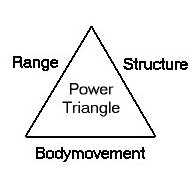 In
our seminars we teach the power triangle: Range, Structure
and body movement. These are the three elements that you
need in order to generate power. If you take away any one of
these elements your power will collapse and you will have to
try to "patch" your technique to make it work. Like the fire
triangle that our model is based on, if you take away one of
these elements the triangle collapses. Which, if you are
talking about putting a fire out is a good thing, but it is
a bad thing if you are trying to generate power.
Unfortunately, as this page has explained many people engage
in actions that rob them of power instead of increases it.
In
our seminars we teach the power triangle: Range, Structure
and body movement. These are the three elements that you
need in order to generate power. If you take away any one of
these elements your power will collapse and you will have to
try to "patch" your technique to make it work. Like the fire
triangle that our model is based on, if you take away one of
these elements the triangle collapses. Which, if you are
talking about putting a fire out is a good thing, but it is
a bad thing if you are trying to generate power.
Unfortunately, as this page has explained many people engage
in actions that rob them of power instead of increases it.
It is important to realize that any and all techniques that you attempt must meet these standards of the power triangle. No amount of patching, jury rigging or esoteric mumbo-jumbo about advanced teachings (what many instructors resort to when confronted with the fact that what they are teaching doesn't work) is going make up for poor body movement.
As we mentioned at the beginning of this page, there is no one way to generate force through the ultimate body movement. Any effective body movement is going to generate power. But what often happens is students unwittingly attempt to combine their autopilot movement or what they think is movement that will generate great power into the proper body movement. This creates mush. That is to say a set of physics that is neither one or the other.
We've waited until now to mention another problem of mushy body movement. Since these mushy movements are not effective, they often end up stalling out when they meet resistance. We cannot tell you how many people we have seen whom, the energy of their technique stalled out and left them standing face to face with a very irritated opponent. Now, instead of the situation being over because their move effectively delivered power, they have a fight on their hands. And from there on, who is going to win becomes a matter of who can take more punishment. Unless their opponent can effectively deliver his own force, whereupon the Clausewitz quote at the top of this page is going to come home to roost.
Therefore in your training pay close attention to the body mechanics of what you are attempting to do. You do not gain more power by throwing more and more movement into your techniques. What motion you do have there should all be directed towards the same target. For example, to generate extra power from you hips, you do not need to turn you hips to the 45, much less the 90. Such an action causes your body's momentum to go spinning of in another direction than where you want it directed. A small motion of mere inches, is enough to accelerate your mass that much more while still keeping on target.
Hopefully this page has helped you to both to understand many of the mistakes that people engage in while trying to generate power and clarified some of the ideas your instructor/sifu/sensei has been trying to communicate to you. Take this information and these explanations and review the moves of your system in this new light. I think you will be pleasantly surprised at how much more effective you will be.

1) To say nothing about the injuries that such systems cause to their students. Physics exist, there is no denying this. The same bad physics that are NOT going into an opponent are often straining, stressing and creating cumulative injury in the practitioner. Return to Text
2) I would like to thank Guru Stevan Plinck of Pukalan Pentjak Silat Serak for the explanation and development of the term "generate and receive force". It is a perfect crystallization of a greatly over-looked and poorly explained principle. A critical principle that must be addressed by training, but most of the time is not. Return to Text
3) Exactly how unaware we can be about our body movement can be seen in the "nervous habits" of many people. When concentrating or under stress many people display tics, twitches and other movements that they are not even aware of, e.g. tapping fingers, stroking beards, tapping pencils etc. The person can truly be unaware that his/her body is performing these autopilot actions. Return to Text
4)As opposed to stepping into a blow from someone who has structure and body movement -- which is NOT a good idea A person who has these elements can tighten muscles around structure + and alter his body movement to deliver force anywhere along the process. Como se de se "Ouch?" Return to Text

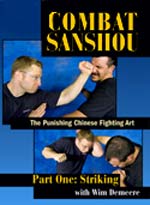
Combat Sanshou: Striking
Learn More >
Order Now!

Fighter's Guide to Heavy Bag
Training (DVD)
Learn More >
Order Now!

Fighter's Guide to Heavy Bag
Training (Book)
Learn More >
Order Now!

Filipino Kuntao
Learn More >
Order Now!

Fighting Arts of
Indonesia
Learn More >
Order Now!

Far Beyond Defensive Tactics
Learn More >
Order Now!

Reflex Action
Learn More >
Order Now!

Experience- & Reality-Based
Self-Defense
Learn More >
Order Now!

Escape Combatives
Special Bonus Feature
ESCAPE DRIVING
Learn More >
Order Now!
Fighting Footwork of Kuntao/Silat Volume 1
Learn More >

Real Fighting
Learn More >
Order Now!

TACSAFE
Learn More >
Order Now!

Fighting Footwork of Kuntao/Silat
Volume 2
Learn More >
Order Now!

Pukulan Pentjak Silat
Learn More >
Order Now!

Fighting Footwork of Kuntao/Silat
Volume 3
Learn More >
Order Now!

Beyond Brazilian Jujitsu
Learn More >
Order Now!

Ground Combatives for Police
Learn More >
Order Now!
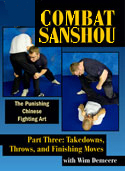
Combat Sanshou:
Takedowns/Throws
Learn More >
Order Now!

Fighting Footwork of Kuntao/Silat
Volume 4
Learn More >
Order Now!
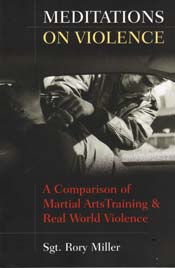
Meditations on Violence
Learn More >
Order Now!

Speed Training
Learn More >
Order Now!
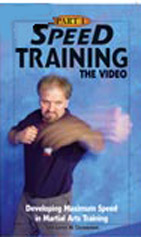
Speed Training: The
DVD
Learn More >
Order Now!
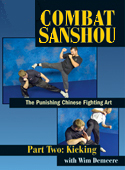
Combat Sanshou: Kicking
Learn More >
Order Now!

Fighting Dirty
Learn More >
Order Now!

Hand to Hand Combat for Police
Officers
Learn More >
Order Now!
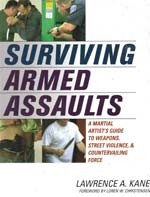
Surviving Armed
Assaults
Learn More >
Order Now!

Street Fighting Essentials
Learn More >
Order Now!
| About navigating this site | Animal List | Bibliography | Bullies | Burglary while on vacation | Classes in Colorado | Car Jacking | Children and Martial Arts | Child Safety | Criminal Mindset | Cults in MA/SD | De-Escalation | E-mail Dianna | E-mail Marc| FAQs | Have MacYoung speak about crime avoidance | Home Page | Home Defense | Hosting a Seminar | Fear | Five Stages of Crime | Knife Fighting | Legal Issues | LEO/Correctional Officer/EMS | Linking policy | Links | Martial Arts | Photo Gallery | Property Crime | Psychology | Rape | Robbery | Safe Dating | Self-Defense Training | Selling your books/DVDs on NNSD | Seminar Schedule | Stalking/Domestic Violence | Street Fighting | Terms of Use | Testimonials | Train with Marc MacYoung | Who is Dianna Gordon MacYoung? | Who is Marc "Animal" MacYoung? | Victimhood | Workplace Problems | Zero Tolerance | ||
| © 1998-2008 No Nonsense Self-Defense, LLC. All rights reserved. |